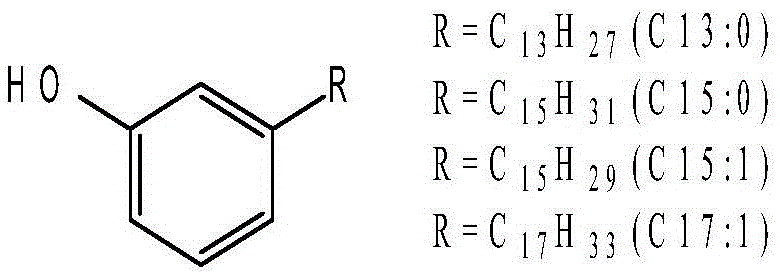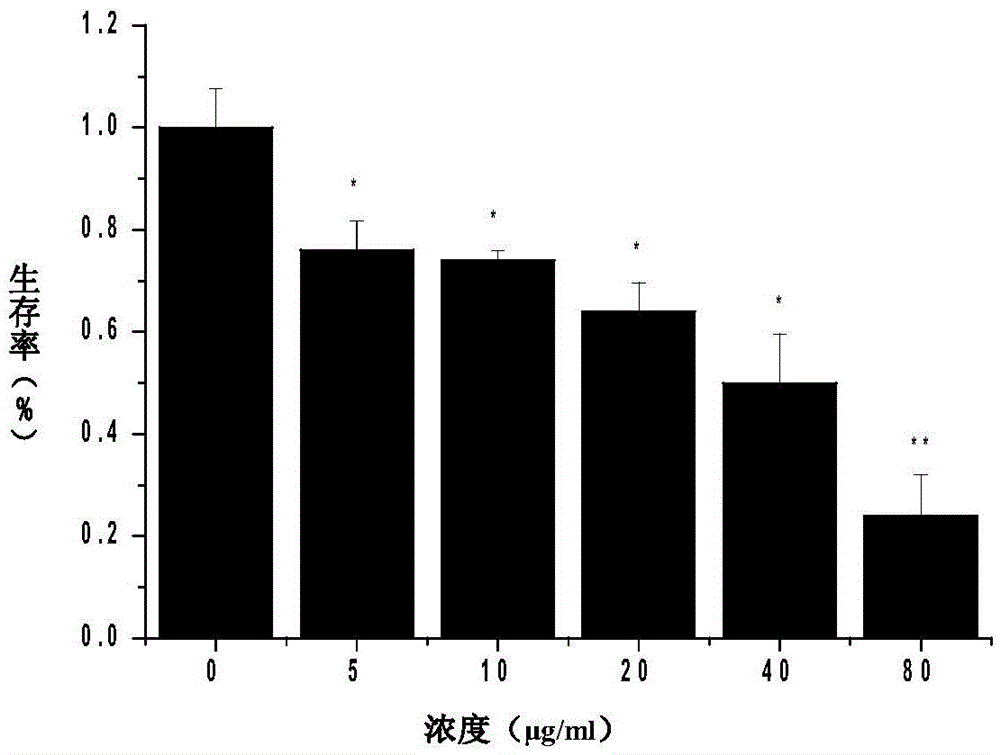Ginkgol containing medicine composition for treating liver cancer
A technology for treating liver cancer and ginkgo phenol, which is applied in the directions of drug combination, active ingredients of hydroxyl compounds, medical raw materials derived from Ginkgo biloba, etc.
- Summary
- Abstract
- Description
- Claims
- Application Information
AI Technical Summary
Problems solved by technology
Method used
Image
Examples
Embodiment 1
[0024] This example illustrates the preparation of the active ingredient ginkgo biloba in anti-liver cancer drug preparations.
[0025] Experimental materials: Ginkgo biloba testa was collected from Zhenjiang City, Jiangsu Province, 200-300 mesh column chromatography silica gel, and other reagents were purchased from Shanghai Chemical Reagent Co., Ltd., analytically pure, without further treatment before use.
[0026] Experimental method: Weigh 100 g of dried Ginkgo biloba testa and pulverize it, ultrasonically extract 5 times the amount of petroleum ether three times, each time for 2 hours, combine the extracts, evaporate the solvent to obtain a petroleum ether extract. Dissolve the extract in a small amount of petroleum ether and apply it to a silica gel column (Φ3.2×40cm), elute with petroleum ether: ether: formic acid = 89:11:1 (v / v / v), and perform thin-layer chromatography Fluorescence was detected at 254nm, and the ginkgolic acid fraction was collected.
[0027] Take 1....
Embodiment 2
[0030] This example verifies the inhibitory effect of ginkgo biloba on the growth of HepG2 cells (human liver cancer cell line) in vitro
[0031] Experimental materials: Human liver cancer cell line HepG2 was purchased from the Shanghai Cell Bank of the Chinese Academy of Sciences and preserved by Jiangsu University School of Medicine. Ginkgo biloba homologues were extracted from Ginkgo biloba testa in our laboratory (HPLC content >95%); DMEM cell culture medium and fetal bovine serum were purchased from Gibco; trypsin was purchased from Invitrogen; stored at -20°C; thiazolyl blue ( MTT), Giemsa dye; dimethyl sulfone (DMSO for short).
[0032] Experimental method: Take HepG2 cells in the logarithmic growth phase, digest with 0.25% trypsin, and dilute with DMEM complete culture solution to adjust to 5×10 4 Add 100 μl of cell suspension to each well of a 96-well plate, and use cell-free complete culture medium as the blank group. Place in a 37°C, 5% CO2 cell culture incubator....
Embodiment 3
[0038] This example verifies the synergistic effect of ginkgo biloba on the growth of HepG2 human liver cancer cells inhibited by cisplatin in vitro
[0039] Experimental materials: Human liver cancer cell line HepG2 was purchased from the Shanghai Cell Bank of the Chinese Academy of Sciences and preserved by Jiangsu University School of Medicine. Ginkgo biloba homologues were extracted from Ginkgo biloba testa in our laboratory (HPLC content >95%); DMEM cell culture medium and fetal bovine serum were purchased from Gibco; trypsin was purchased from Invitrogen; stored at -20°C; thiazolyl blue ( MTT), Giemsa dye; dimethyl sulfone (DMSO for short), cisplatin (Sigma, product number 479306).
[0040] Experimental method: with embodiment 2. After the cells adhered to the wall, add a single cisplatin 10μg / ml and a mixture of cisplatin 10μg / ml and 5, 10, 20, 40, 80μg / ml of ginkgo biloba and culture for 24 hours, then add 5mg / ml of MTT solution to each well 10 μl, continue to incubate...
PUM
 Login to View More
Login to View More Abstract
Description
Claims
Application Information
 Login to View More
Login to View More - Generate Ideas
- Intellectual Property
- Life Sciences
- Materials
- Tech Scout
- Unparalleled Data Quality
- Higher Quality Content
- 60% Fewer Hallucinations
Browse by: Latest US Patents, China's latest patents, Technical Efficacy Thesaurus, Application Domain, Technology Topic, Popular Technical Reports.
© 2025 PatSnap. All rights reserved.Legal|Privacy policy|Modern Slavery Act Transparency Statement|Sitemap|About US| Contact US: help@patsnap.com



